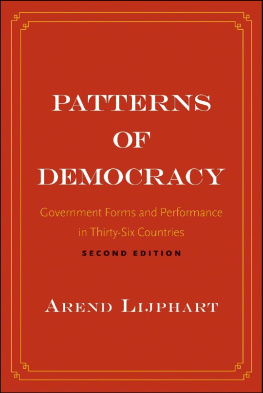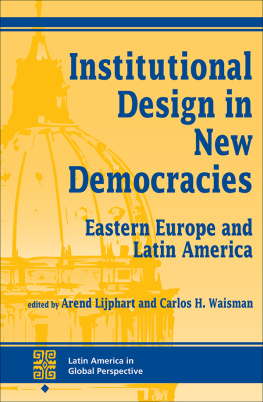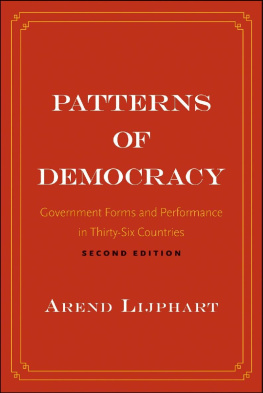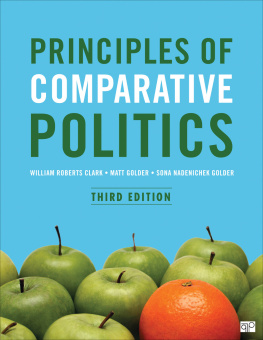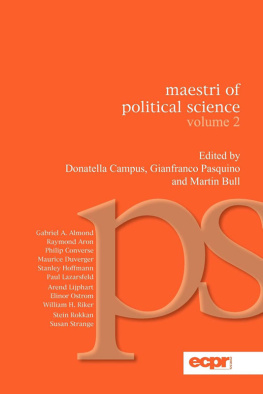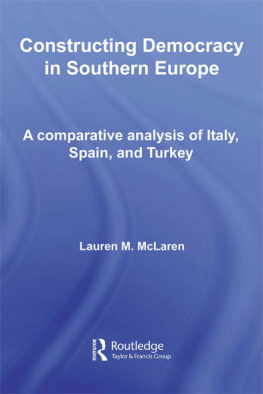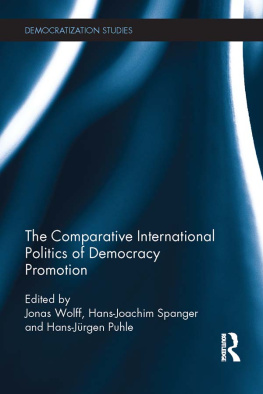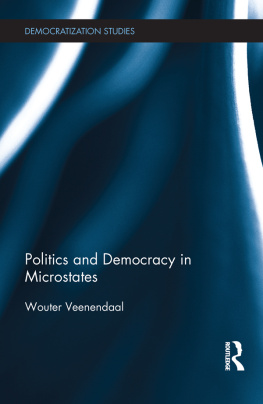PATTERNS OF DEMOCRACY
PATTERNS OF DEMOCRACY
Government Forms and Performance in Thirty-Six Countries
SECOND EDITION
AREND LIJPHART

First edition 1999. Second edition 2012.
Copyright 1999, 2012 by Arend Lijphart.
All rights reserved.
This book may not be reproduced, in whole or in part, including illustrations, in any form (beyond that copying permitted by Sections 107 and 108 of the US Copyright Law and except by reviewers for the public press), without written permission from the publishers.
Yale University Press books may be purchased in quantity for educational, business, or promotional use. For information, please e-mail sales.press@yale.edu (US office) or sales@yaleup.co.uk (UK office).
Set in Melior type by Integrated Publishing Solutions, Grand Rapids, Michigan.
Printed in the United States of America.
Library of Congress Cataloging-in-Publication Data
Lijphart, Arend.
Patterns of democracy : government forms and performance in thirty-six countries / Arend Lijphart. 2nd ed.
p. cm.
Includes bibliographical references and index.
ISBN 978-0-300-17202-7 (paperbound : alk. paper) 1. Democracy.
2. Comparative government. I. Title.
JC421.L542 2012
320.3dc23
2012000704
A catalogue record for this book is available from the British Library.
This paper meets the requirements of ANSI/NISO Z39.481992 (Permanence of Paper).
10 9 8 7 6 5 4 3 2 1
for
Gisela and
for our grandchildren,
Connor,
Aidan,
Arel,
Caio,
Senta, and
Dorian,
in the hope that the twenty-first centurytheir centurywill yet become more democratic, more peaceful, kinder, and gentler than the one our generation has bequeathed to them
CONTENTS
PREFACE TO THE SECOND EDITION
I welcome the opportunity to publish an updated edition of Patterns of Democracy, originally published in 1999, because it gives me an opportunity to test whether my main findings and conclusions continue to be validespecially my finding that the great variety of formal and informal rules and institutions that we find in democracies can be reduced to a clear two-dimensional pattern on the basis of the contrast between majoritarian and consensus forms of government, and my conclusion that consensus democracies (measured on the first of these dimensions) have a superior record with regard to effective policy-making and the quality of democracy compared with majoritarian democracies. The basic organization of the book has not changed, but the data on which its empirical analysis is based has changed in important ways.
First, my analysis continues to compare the same number of democraciesthirty-sixbut three of the countries had to be removed because they are no longer free and democratic according to the criteria of Freedom House: Colombia, Venezuela, and Papua New Guinea. I replaced them with Argentina, Uruguay, and Korea, which returned to democracy in the 1980s.
Second, I extended the analysis from 1996 to 2010, which entails a considerable increase in the time span during which the other thirty-three democracies are analyzed: a 74 percent increase for the newest democracies included in the first editionIndia and Spainsmaller but still substantial increases for the countries that became democratic between the 1950s and the early 1970s, and even a significant 28 percent increase for the older democracies analyzed from the late 1940s on.
Third, I made no major changes in the definition and measurement of the ten basic variables that make up the majoritarian-consensus contrast, with two important exceptions. In hindsight, I concluded that the way I operationalized executive dominance in to a more appropriately short addendum to that chapter.
Fourth, the biggest changes are in entirely new variables not used in the original edition at all. I also streamlined the presentation of the results of the regression analyses. Instead of showing the bivariate relationships between consensus democracy and the performance variables in the tables and discussing the influence of control variables, especially the impact of the level of economic development and population size, in the accompanying text, I now have tables showing multivariate regression analyses of the effects of consensus democracy with these two standard controls in place in all instances.
Generally the quality of all the new data is a great deal better than the quality of the data that I had at my disposal in the mid-1990s, and they are available for many more countries. In particular, I made grateful use of two entirely new and highly relevant datasets for the measurement of the quality of government and the quality of democracy, respectively: the Worldwide Governance Indicators and the data of the Democracy Index project of the Economist Intelligence Unit. Not only have excellent data become much more available in the past decade, but they have also become more easily accessible. In the preface to the first edition, I wrote that I might not have been able to write it without the invention of email. I can now add that this new edition might not have been possible, or would have been much more difficult to write, without all of the information that is available on the internet.
To briefly preview my conclusions in the updated edition, I find that my original conclusions are amply confirmed. In fact, the evidence with regard to the interrelationships of my ten majoritarian versus consensus characteristics and with regard to the superior performance of consensus democracy has become even clearer and stronger.
The preparation of a study of as many as thirty-six countries is impossible without the input of many comparative and country experts. I am deeply grateful to my friends and colleagues for the valuable advice and assistance I received from them. First of all, I want to express my thanks again to everyone who helped me with the first edition of this book. Their input is still reflected in the contents of this second edition, too.
I was especially in need of assistance with regard to the three new countries in the updated edition, and I am grateful for the excellent advice on Korean politics from Taekyoon Kim, Kyoung-Ryung Seong, Jong-Sung You, and my Korean research assistant, Don S. Lee. For Argentina and Uruguay I had a huge team of aides and advisers, and I am deeply indebted to them all: David Altman, Octavio Amorim Neto, Marcelo Camerlo, Rossana Castiglioni, Sebastin Etchemendy, Mark P. Jones, Jorge Lanzaro, Andrs Malamud, M. Victoria Murillo, Sebastin M. Saiegh, and Andrew Schrank. For recent developments in several other countries I relied on the advice of Edward M. Dew, Fragano S. J. Ledgister, Ralph R. Premdas, and Rajendra Ramlogan (Barbados and the other Caribbean countries); Carl Devos and Luc Huyse (Belgium); Pradeep K. Chhibber and Ashutosh Varshney (India); Yuko Kasuya and Mikitaka Masuyama (Japan); Deborah Brutigam, Jrgen Elklit, Shaheen Mozaffar, Linganaden Murday, and Nadarajen Sivaramen (Mauritius); Peter Aimer and Jack Vowles (New Zealand); Richard Gunther and scar Martnez-Tapia (Spain); Matthew Flinders, Michael Gallagher, and Thomas C. Lundberg (United Kingdom); and Gary C. Jacobson (United States).
I am equally grateful to all of the scholars who helped me in important subject areas: Krista Hoekstra, Hans Keman, Jelle Koedam, and Jaap Woldendorp (cabinet coalitions); Daniel M. Brinks, Isaac Herzog, Donald W. Jackson, and Mary L. Volcansek (judicial review); Christopher Crowe and Mauro F. Guilln (central banks); and Scott Desposato, Stephen J. K. Lee, Philip G. Roeder, and Sebastin M. Saiegh (statistical and computer issues). Other scholars whom I would like to thank without placing them in country or subject categories are Ernesto Alvarez, Jr., Julian Bernauer, Joseph H. Brooks, Royce Carroll, Josep M. Colomer, Zachary Elkins, John Gerring, Ronald F. Inglehart, Mona Lena Krook, Sanford A. Lakoff, Dieter Nohlen, Matt H. Qvortrup, Manfred G. Schmidt, Alan Siaroff, Fabia Soehngen, Rein Taagepera, Steven L. Taylor, and Adrian Vatter.
Next page
